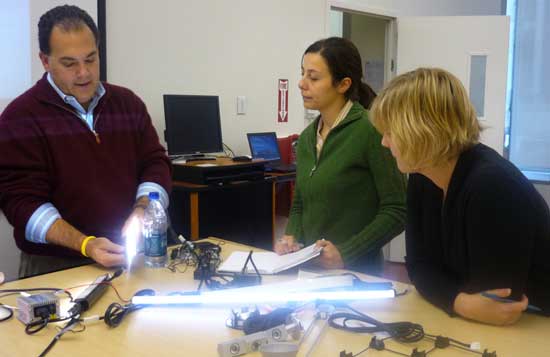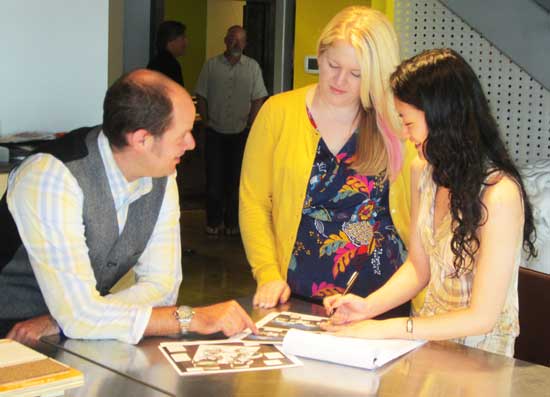The students of the 2012 graduating class who earned their master’s degrees in exhibit design at the Fashion Institute of Technology (FIT) are ready to join the exhibit industry. Students are required to serve an eight-week internship to fulfill their graduation. Many of the 16 students elected to do their internship in the tradeshow exhibit industry, while others chose companies specializing in museum, retail and interior design areas.

This year, two students elected to complete their internships internationally at German exhibit companies. Will Krause worked at Heilmaier Design in Munich and Michael Moolenschot served at von Hagen Design in Blomberg, outside of Hanover.
The international segment of the world of tradeshow exhibiting is growing rapidly and exposure to different design paths will play an important role in the future.
“Many exhibit companies in Germany are family-owned,” said Krause. “It felt unusual to me that the company owner was someone that I saw at work every day. He was very open with his employees. I’m used to working where the teams are more divided and don’t meet each other in the company halls so often. This created a calm and secure environment.”
The real-world experience Krause gained from the internship definitely left its mark on the student.
“After being in school at FIT, I was used to having my assignments clearly spelled out by my instructors, but here at Heilmaier I needed to spend time figuring out what a project really needed first, and then give myself a work assignment and a deadline,” said Krause. “After working individually on many of my projects at FIT, it was nice to be working as part of a design team at Heilmaier. It gave me a chance to validate my assumptions.”
Krause was also surprised at how much his internship resembled normal working conditions in the industry.
“I wasn’t expecting my work to find its way into the hands of real clients so quickly,” he said. “I found myself in the middle of a very busy time at Heilmaier. As soon as I finished some of my designs they were assembled into the presentation and shown to the client.”
Krause also quickly discovered that his education had gone a long way toward preparing him to be an exhibit designer.
“I think that was my biggest surprise, realizing that FIT had taught me skills that were valuable in the workplace,” said Krause. “During school, I was thinking ‘well, I’m enjoying this, but will this actually lead to work?’ Now, it seems like it actually might.”
Michael Moolenschot also experienced working in a real-world business environment at von Hagan Design.
“Working on real projects gave me pride and joy,” said Moolenschot. “My lessons at FIT readily applied and I (immediately) felt like a part of the design team.”
Axel von Hagen, owner of von Hagen Design, is now a firm believer in the FIT internship program.
“Michael’s energy and American point of view allowed the design team to learn from each other,” said von Hagen. “We plan to take on another FIT student next year.”
Another one of the FIT student interns, Martha Hao, served at 3D Exhibits in Chicago.
“I used to hear horror stories about how interns, especially in the design field, got bullied by their superiors or were treated as coffee runners,” said Hao. “It is exactly the opposite at 3D Exhibits. My creative directors, Jon Horn and Jeff Bartle, treated me with respect and as if I was a full-time employee.
“I can say this is by far the most enlightening and exhilarating experience I’ve ever had,” said Hao. “3D Exhibits not only allowed me to hone my skills in preparation for the real world, it also taught me the business aspect of the tradeshow industry.”
Once of the most eye-opening aspects of the internship for Hao was the deadlines that designers are under in the tradeshow industry. She learned that time management would go a long way in shaping her success as a designer.
“The deadlines required to turn things around are incredibly quick,” said Hao. “I was immediately expected to contribute to the work load. In school, students have an ideal time frame to complete projects. In the real world, it’s not so ideal. Deadlines are unpredictable. It was good practice for me to sharpen my sense of time and my ability to divide my time wisely for each project.”
Jon Horn, senior vice president of creative for 3D Exhibits, provided guidance for Hao during her internship.
“Since the FIT intern sponsorship program is designed to first and foremost benefit the student, it seemed only appropriate to first develop a strategy for success with Martha,” said Horn. “This meant she would be jumping right in and collaborating with the creative team on a variety of opportunities. As a team designer, there were some projects where she was called upon to come up with the big idea, and others where she was asked to contribute to the team’s collective solution.”
Fortunately for Hao, there was no time left for delivering coffee to the rest of the design team.
“The expectation is that the student is approaching the internship as though it’s their first job opportunity,” said Horn. “Like any entry-level designer, we capitalized on Martha’s creative strengths and worked with her on areas we collectively identified as needing added focus, instruction and practice. We enjoyed Martha’s time with us and felt it was a mutually beneficial experience.”
According to Professor Brenda Cowan, FIT chairperson for exhibition design, there have been a number of success stories just like these from the internship program.
“Working with external industry sponsors during their internships, students are immersed in a forum of experimentation where they can maximize their experiences to truly uncover unique ends,” said Cowan. “Through these direct industry experiences, our students are able to hone their skills as technical designers and learn the essential areas of management that go into working on multiple and short turnaround projects.”
Over the last 10 years, the FIT exhibit training program has developed into a valuable stepping stone for new designers to enter the world of exhibition design. Just ask some of your co-workers. They are probably graduates.






























